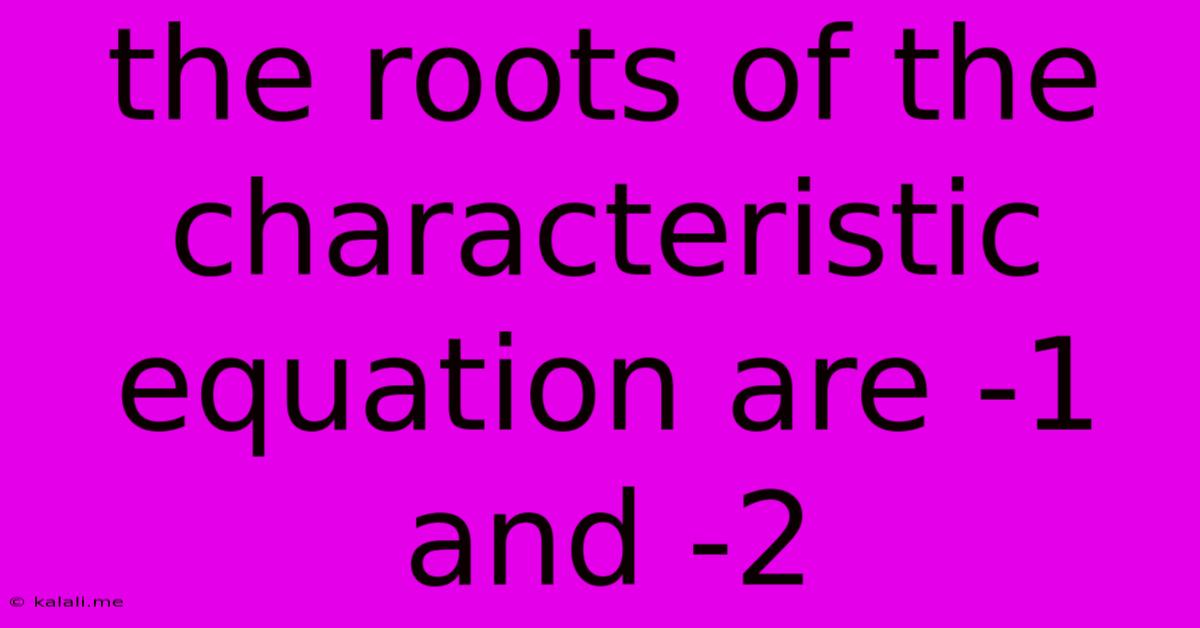The Roots Of The Characteristic Equation Are -1 And -2
Kalali
May 24, 2025 · 3 min read

Table of Contents
The Roots of the Characteristic Equation: -1 and -2
This article explores the implications of having -1 and -2 as the roots of a characteristic equation, primarily focusing on its application in solving linear ordinary differential equations (ODEs) and understanding the resulting system's behavior. We'll delve into the types of systems these roots represent and how they influence the system's stability.
The characteristic equation is a polynomial equation derived from a linear homogeneous ODE. Its roots directly determine the form of the general solution. Knowing that the roots are -1 and -2 provides valuable insight into the system's dynamics.
Understanding the Implications of Roots -1 and -2
The roots of the characteristic equation represent the eigenvalues of the system's matrix representation (in the case of systems of ODEs). Since we have two distinct real roots, -1 and -2, this indicates:
-
Distinct Real Eigenvalues: This implies that the system is not exhibiting oscillatory behavior. The solution will be a combination of exponentially decaying terms.
-
Stability: Both roots are negative. This is crucial, as it guarantees the system's stability. A negative real root signifies an exponentially decaying solution; the further the root is from zero, the faster the decay. In this case, with roots -1 and -2, the system will converge to its equilibrium point relatively quickly, with the component associated with the root -2 decaying faster.
Constructing the General Solution
Let's assume our second-order linear homogeneous ODE takes the general form:
ay'' + by' + c*y = 0
Where 'y' represents the dependent variable, and 'a', 'b', and 'c' are constants. The characteristic equation would be:
ar² + br + c = 0
With roots r₁ = -1 and r₂ = -2. The general solution to this ODE would then be:
y(t) = C₁e^(-t) + C₂e^(-2t)
Where C₁ and C₂ are arbitrary constants determined by initial conditions.
System Behavior and Stability Analysis
The presence of negative real roots, -1 and -2, dictates the system's behavior:
-
Exponential Decay: Both terms,
e^(-t)ande^(-2t), represent exponential decay. This means the system's response to any perturbation will diminish over time, approaching zero asymptotically. -
No Oscillations: The absence of complex or imaginary components in the roots rules out any oscillatory behavior. The system's response will be purely damped, without any oscillations.
-
Faster Decay for Root -2: The term
e^(-2t)decays faster thane^(-t). This means that the component of the solution associated with the root -2 will disappear more quickly than the component associated with the root -1.
Higher-Order Systems
The principles discussed here can be extended to higher-order linear homogeneous ODEs. If a higher-order system possesses only negative real roots (including repeated roots), the system will always be stable, with each term in the solution exhibiting exponential decay. The rate of decay is directly related to the magnitude of each root.
Conclusion
Having -1 and -2 as the roots of a characteristic equation signifies a stable system exhibiting purely exponential decay. The specific values of the roots determine the rate of decay, with larger negative values indicating faster decay. This information is crucial for understanding and predicting the behavior of dynamic systems governed by linear ODEs. Analyzing the roots provides invaluable insights into system stability and the overall nature of the solution.
Latest Posts
Latest Posts
-
What Is The Major Reason That Atoms Join Together
May 24, 2025
-
I Will Have War With Amalek
May 24, 2025
-
On Your Mark Get Set Go
May 24, 2025
-
How Do You Get Gas Smell Off Hands
May 24, 2025
-
The Square Of Sum As Integral
May 24, 2025
Related Post
Thank you for visiting our website which covers about The Roots Of The Characteristic Equation Are -1 And -2 . We hope the information provided has been useful to you. Feel free to contact us if you have any questions or need further assistance. See you next time and don't miss to bookmark.